
Transportation in the Philippines covers the transportation methods within this archipelagic nation of over 7,500 islands. From a previously underdeveloped state of transportation, the government of the Philippines has been improving transportation through various direct infrastructure projects, and these include an increase in air, sea, road, and rail transportation and transport hubs.
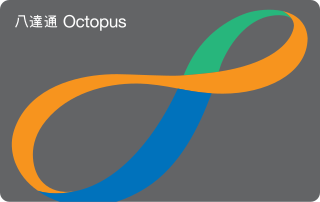
The Octopus card is a reusable contactless stored value smart card for making electronic payments in online or offline systems in Hong Kong. Launched in September 1997 to collect fares for the territory's mass transit system, the Octopus card system became the world's second contactless smart card system, after the Korean Upass, and has since grown into a widely used payment system for all public transport in Hong Kong. Octopus's success has led to the development of the Navigo card in Paris, the Oyster Card in London, the Opal card in New South Wales, NETS FlashPay, EZ-Link in Singapore, and other similar systems.

SmarTrip is a contactless stored-value smart card payment system managed by the Washington Metropolitan Area Transit Authority (WMATA). The Maryland Transit Administration (MTA) uses a compatible payment system called CharmCard. A reciprocity agreement between the MTA and WMATA allows either card to be used for travel on any of the participating transit systems in the Baltimore-Washington metropolitan area. Unlike traditional paper farecards or bus passes, SmarTrip/CharmCard is designed to be permanent and reloadable; the term "SmarTrip" may refer to both payment systems unless otherwise noted.
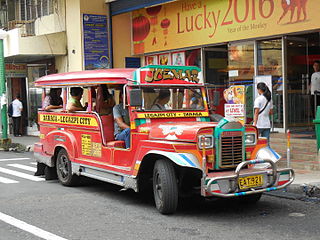
Jeepneys, sometimes called jeeps, are minibus-like public utility vehicles, serving as the most popular means of public transportation in the Philippines. They are known for their crowded seating and kitsch decorations, which have become a widespread symbol of Philippine culture and art. A Sarao jeepney was exhibited at the Philippine pavilion at the 1964 New York World's Fair as a national image for the Filipinos.
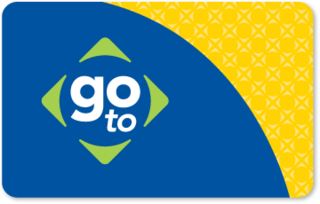
The Go-To card is a contactless smart card used to pay fares for bus, light rail, and commuter rail lines operated by Metro Transit and other transit agencies in the Twin Cities area of Minnesota. The system has significantly sped up boardings on area buses while alleviating wear and tear on existing ticket machines and fare boxes. The old magnetic strip reading machines were weather sensitive and could not be placed out in the elements like at the Hiawatha Line light rail stations.

The Manila Light Rail Transit System, commonly known as the LRT, is an urban rail transit system that primarily serves Metro Manila, Philippines. Although categorized as a light rail system because it originally used light rail vehicles, it presently has characteristics of a rapid transit system, such as high passenger throughput, exclusive right-of-way, and later use of full metro rolling stock. The LRT is jointly-operated by the Light Rail Transit Authority (LRTA), a government corporation attached to the Department of Transportation (DOTr), and the Light Rail Manila Corporation (LRMC). Along with the Manila Metro Rail Transit System and the Metro Commuter Line of the Philippine National Railways, the system makes up Metro Manila's rail infrastructure.
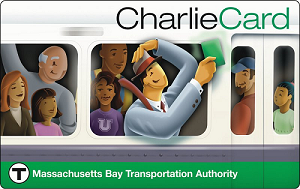
The CharlieCard is a contactless smart card used for fare payment for transportation in the Boston area. It is the primary payment method for the Massachusetts Bay Transportation Authority (MBTA) and several regional public transport systems in the U.S. state of Massachusetts.

Because the rail operators are government-assisted profit-based corporations, fares and ticketing on Singapore's Mass Rapid Transit (MRT) system are currently aimed at least in breaking even to at least compensate for their costs of running the system. The rail operators collect fares by selling electronic tickets capable of storing data, the price of which is calculated based on the distance between the start and destination stations. These prices increase in fixed stages for standard non-concessionary travel. From the information that was earlier written in these tickets, it is possible to increase the fare according to increments based on approximate distances between stations.

The Light Rail Transit Line 1, commonly referred to as LRT Line 1 or LRT-1, is a light rapid transit system line in Metro Manila, Philippines, operated by Light Rail Manila Corporation (LRMC) and owned by the Light Rail Transit Authority (LRTA) as part of the Manila Light Rail Transit System. Originally referred to as Metrorail and the Yellow Line, LRT Line 1 was reclassified to be the Green Line in 2012. It travels in a general north–south direction from Baclaran to Monumento, and then east–west from Monumento to Roosevelt. Currently, the line consists of 20 stations and runs on 19.65 kilometers of fully elevated route. Although it has the characteristics of light rail, such as with the type of rolling stock used, it is more akin to a rapid transit system owing to its total grade separation and high passenger throughput.

The transportation system in Metro Manila is currently inadequate to accommodate the mobility and other basic needs of a densely populated metropolis, the result of many factors and problems that the government has failed to provide or address. Metro Manila exists in a state of near-permanent gridlock, with people and goods trapped by the very system that is supposed to move them quickly and efficiently. Car ownership has also risen dramatically, both because of the insufficient public transportation network and of cars being viewed as status symbols. In recent years, however, the Philippine government has been pushing to improve the mass transit system through various infrastructure projects, hoping to solve the interlinked problems of transportation, land use and environment.

The Bonifacio Transport Corporation, or more commonly known as BGC Bus or formerly The Fort Bus, is an intercity bus company in Metro Manila, the Philippines, serving routes that connect Makati, Bonifacio Global City, and Taguig.
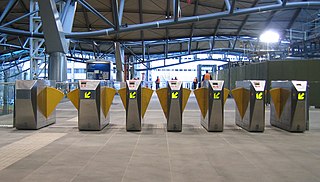
An automated fare collection (AFC) system is the collection of components that automate the ticketing system of a public transportation network - an automated version of manual fare collection. An AFC system is usually the basis for integrated ticketing.

The Troika card is a contactless reusable card designed to pay for public transport in Moscow. It is the centrepiece of the new ticketing menu introduced in Moscow on April 2, 2013.

Beep is a reloadable contactless smart card created in 2015 to be a replacement for the magnetic card-based system in paying rail based rapid transit transportation fares in and around Metro Manila. Beep is also used in lieu of cash in some convenience stores and other businesses. The Beep system is implemented and operated by AF Payments Incorporated, which is primarily owned by Ayala Corporation and Metro Pacific Investments Corporation.

The Public Utility Vehicle Modernization Program (PUVMP) was launched by the Department of Transportation of the Philippines in 2017, with the goal of making the country's public transportation system efficient and environmentally friendly by 2020. The program calls for the phasing-out of jeepneys, buses and other Public Utility Vehicles (PUVs) that are at least 15 years old and replacing them with safer, more comfortable and more environmentally-friendly alternatives over the next three years. Currently, there are 220,000 jeepney units operating throughout the country.
OMNY is a contactless fare payment system, currently being implemented for use on public transit in the New York metropolitan area. When OMNY is completely rolled out, it will replace the MetroCard on the New York City Subway, the Staten Island Railway, PATH trains, MTA buses, Bee-Line buses, and NICE buses. OMNY will also expand beyond the current scope of the MetroCard to include the Long Island Rail Road and Metro-North Railroad. As of December 31, 2020, OMNY is available on all MTA buses and at all subway stations.
Transportation within Cebu City is mainly land-based with most parts of the city accessible by road. There is no existing mass transit but there is an existing proposal for a Cebu Bus Rapid Transit System and Cebu Light Rail Transit System.

Pronto, stylized as PRONTO, is the second-generation contactless payment system for automated fare collection on public transit services in San Diego County, California. The system is managed by the San Diego Association of Governments, operated by INIT Systems, and is valid on all services operated by the Metropolitan Transit System, and on North County Transit District. It launched on September 1, 2021, replacing the first-generation Compass Card system. Pronto involved the installation of new fare machines at all transit stations. It was the first contactless smart card introduction in California during the COVID-19 pandemic.

The GET City Optimized Managed Electric Transport (COMET) is an electric minibus developed by American firm Pangea Motors and manufactured and distributed by Global Electric Transport.


















